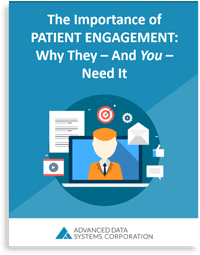Healthcare Blog
The latest in all things RCM, Electronic Health Records, Radiology Information Systems, Practice Management, Medical Billing, Value-Based Care, & Healthcare IT.

By:
Stephen O'Connor
March 20th, 2015
Not all medical practices will adopt emerging technology at the same rate. Some organizations have more resources and more forward-thinking people on their payroll, which means that they will use the latest software and technology solutions to make things easier on their staff and patients. Your behavioral/mental health practice may still rely on using an outdated, paper-based system to keep things running. However, this is an approach that you cannot expect to hang onto for very long, given the complexities of treatment protocols and the ever-increasing connected nature of healthcare providers.

By:
Advanced Data Systems Corporation
March 18th, 2015
The following is an excerpt from our whitepaper, "The Importance of Patient Engagement & Why You Need It." Today it is difficult to think of an industry that does not take advantage of computers, internet access, and specialized software to get work done faster and more efficiently. That, combined with the fact that people (patients) are so accustomed to using computers and smartphones to access and provide information is why they are often surprised when the front desk staff at their medical practice hands them a heavy clipboard with a stack of paper forms to fill out. After all, shouldn’t a medical practice - almost more than any other type of business - be better automated than that?

The Importance of Patient Engagement: Why They - And You - Need It
Learn why patient engagement is a necessity and how you can master it within your practice.

By:
Stephen O'Connor
March 16th, 2015
One of the signs of people who are true professionals is that they are seldom satisfied with the state of their business or the development of their abilities, skills, and knowledge. While you strive to maintain a certain level of service and abilities for each staff member, you know that the medical field is constantly evolving. New techniques become available to help us diagnosis and treat patients as well as to measure how well a particular treatment protocol is working. This means that medical organizations are always in a state of development, with team members needing to stay current on discoveries in their field as well as what current industry best practices are in their niche.

By:
Stephen O'Connor
March 13th, 2015
As a medical professional, you know that your job will typically be easier when everyone in your practice is fully engaged with patients, people are caught up in their work duties, and they are healthy, enthusiastic, and filled with empathy for those they are taking care of. When times are difficult, however, the medical staff may need to take some time to remember the reasons why they selected this profession in the first place.

Industry News | Healthcare Advice
By:
Advanced Data Systems Corporation
March 11th, 2015
The following excerpt is from an article found on Health IT Outcomes. It was written by Christine Kern. While 82% of providers polled express optimism about October’s transition, only 21% believe they are on track for it. A Navicure survey has discovered a curious disconnect regarding ICD-10 preparedness. While 82 percent of respondents reported being optimistic about their readiness for the transition scheduled for October 1, 2015, only 21 percent believe their practices are currently on track to actually meet the deadline.

By:
Stephen O'Connor
March 9th, 2015
Like most medical professionals, you surely have chosen this field because of a sincere desire to help people with your special skills, knowledge, and abilities and not because you were interested in organizing records and examining data about patients. This is why it’s not so surprising that some medical organizations are stuck in the past, using antiquated paper-based systems instead of switching to a computerized process. They may be somewhat aware of the existence of software solutions but have decided that they can get by without it for now.

By:
Christina Rosario
March 6th, 2015
How happy are your current patients with your medical practice? Are you doing everything in your power to make them feel at ease, respected, and listened to? What is the waiting room experience like? The answers to these questions can help determine the future success of your practice. When patients are comfortable and pleased with how the staff treats them (and this includes the amount of forms the staffers make them fill out), they will be more inclined to stay on with you, as well as recommend your services to their friends, family, and neighbors.

Industry News | Healthcare Advice
By:
Advanced Data Systems Corporation
March 2nd, 2015
The following excerpt is from an article on EHR Intelligence. It was written by Vera Gruessner. Marilyn Tavenner, Administrator at the Centers for Medicare Medicaid Services (CMS), announced today that the organization recently finished the first week of end-to-end testing for ICD-10 coding.

Medical Billing / RCM | Industry News
By:
Advanced Data Systems Corporation
February 27th, 2015
The following is an excerpt from our whitepaper, Multiple Tax IDs: Get More Revenue With Fewer Clicks. One of the major challenges faced by medical practices is in managing the flood of information on all their patients in such a way that employees can work as efficiently as possible while maintaining the highest levels of security.

Industry News | Healthcare Advice
By:
Advanced Data Systems Corporation
February 23rd, 2015
The following is an excerpt from an article on Healthcare Finance News. It was written by Henry Powderly. It’s Oct. 1 and the ICD-10 diagnostic coding vocabulary is in effect. Now what? According to one expert, that answer depends on how prepared you are and how much money your organization has on hand. “For some, the transition will be relatively seamless,” said Pam Jodock, senior director of health business solutions for HIMSS North America. “Others may experience a loss in productivity as office staff familiarizes themselves with new coding tools and processes.”